Rosacea: What It Looks Like and What You Can Do
Think your persistent facial redness is just acne or sensitive skin? Rosacea often gets mistaken for both. It usually shows as flushing, visible blood vessels, and sometimes red bumps that look like pimples. Unlike typical acne, rosacea often comes with constant or recurring redness and a tendency to flare with certain triggers.
There’s no single test for rosacea — diagnosis is usually based on how your skin looks and what makes it flare. If you get redness across the nose, cheeks, forehead or chin that comes and goes or stays, that’s a strong clue. Some people also notice burning, stinging, or rough, dry patches.
Common triggers you can control
Knowing what sets off a flare helps more than you’d expect. Common triggers include sun exposure, hot drinks, spicy foods, alcohol, intense exercise, very hot baths, and sudden temperature changes. Emotional stress and certain skincare or cosmetic products can also trigger flares. Start a simple diary for a couple weeks — note meals, weather, activities, and products used to spot patterns.
Realistic treatment and care steps
First: protect your skin from sun. Use a broad-spectrum sunscreen every day and wear a hat when you’re outside. Second: simplify your routine. Swap harsh cleansers and alcohol-heavy products for a gentle, fragrance-free cleanser and a light moisturizer. Avoid exfoliating scrubs and strong acids until things calm down.
Topical treatments your dermatologist may suggest include metronidazole, azelaic acid, or ivermectin creams — these reduce inflammation and bumps. For persistent redness and flushing, topical vasoconstrictors (like brimonidine) can temporarily reduce visible blood vessels. If you have more inflamed bumps, short courses of oral antibiotics such as low-dose doxycycline often help by lowering inflammation, not just fighting bacteria.
For stubborn broken vessels and long-term redness, in-office options like intense pulsed light (IPL) or vascular laser therapy can give good results. Isotretinoin is rarely used but can be considered for severe, resistant cases under specialist care.
Simple lifestyle moves matter: avoid known food or drink triggers, cool down after workouts, use lukewarm water on your face, and choose fragrance-free makeup. Patch-test any new product on a small area before full use.
When should you see a doctor? If redness is getting worse, bumps or eye symptoms appear (itchy, red, gritty eyes), or over-the-counter measures don’t help, book an appointment with a dermatologist. Eye rosacea needs quick attention to avoid damage.
Want practical help finding treatments or pharmacy options? Browse our articles and guides on medications, safe online pharmacies, and skin-friendly product tips. Use the tag list below to find posts related to antibiotics, topical therapies, and patient-friendly buying advice that can help you manage rosacea sensibly and safely.

Rosacea: Understand and Manage This Skin Condition Effortlessly
Rosacea is a common skin condition that often causes redness on the face and can be mistaken for acne or other skin problems. While there's no one-size-fits-all solution, understanding its triggers and how to manage flare-ups can make a big difference. From avoiding certain foods to using the right skincare products, the right approach can help maintain healthier skin. This article provides insight into identifying rosacea and offers practical steps to manage it effectively.
© 2025. All rights reserved.
